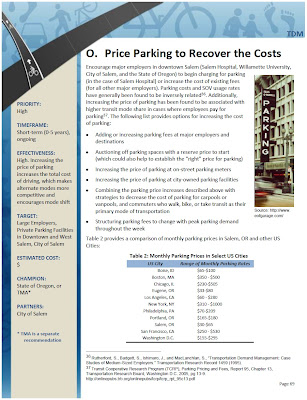 |
| Lots of residential West Salem is far from a bus stop |
 |
| Not surprisingly there are few boardings in the hills |
But of course "over 7,000 West Salem residents work outside of the area. Most of these workers have jobs located in downtown Salem."
 |
| "most of these workers have jobs located in downtown Salem" |
But of course in the background is the giant bridge and highway - a capital expense problem:
 |
| Count 'em! A bridge will cost at least ten Courthouse Squares |
(It is interesting that the study team does not seem to have targeted downtown employers with West Salem employees. Photos from the open houses are perhaps revealing in this regard - here, here, and here. It may not be a coincidence that the project name "capturing the ride" alludes to "captive" riders as opposed to "choice" riders - though here's Jarrett Walker, who is conducting another Cherriots study, on why those are lousy terms.)
 |
| The River Crossing Alternate Modes Study and Transit: Improve Transit Service, Increase Service Frequency |
But in not linking conversations about the bridge to conversations about transit, we tacitly trade an operating problem for much bigger capital problem.
Free parking might be the single-most important factor, and it has been disappointing that many who advocate against the thrid bridge are not also able to see the ways that our failure to price parking appropriately makes the drive-alone trip too cheap and easy, which in turn props up demand for inefficient drive-alone bridge crossings.
One of the costs of our free or cheap parking policy is that it hampers our transit agency's ability to provide quality service. Too often free parking means lousy bus service! Manhattan has a great subway because parking's too damn expensive - because land is too valuable to waste on large amounts of car storage.
 |
| Salem River Crossing Alternate Modes Study |
In every way, a robust transit system is key to eliminating the wish for a costly and risky giant bridge and highway.


7 comments:
I am of course in agreement with you, as usual, except you overstate the case when you say "free parking might be the single-most important factor" encouraging drive-alone commuting from West Salem.
Parking is not free for state employees. It is actually quite expensive to park in a state garage or on the street. Downtown employees are not supposed to park on the street but the City apparently doesn't provide adequate enforcement of this. I don't know if Salem Hospital and Willamette charge their employees for parking, but they should.
If all major employers on the east side charged adequately for parking and the City adequately enforced the ban on employee parking downtown, this would go a long way toward encouraging more commuting by alternate modes.
There's also Mark Wigg's great idea to allow free commuter parking in Wallace Marine Park M-F to encourage walking and biking to work over the Union St. Bridge. Why doesn't the City implement this idea immediately?
Is part of the problem with buses in West Salem that there are so few through streets and many that go through are either too narrow or too poor condition to endure the wear and tear of a bus?
I live just beyond the bus route on Doaks Ferry and I doubt a lot of people would use it from this area because you have to go over a very steep hill to get to that street. I wonder why they do not bring the bus down Titan instead. You could get the high school and the residential areas as well. Doaks Ferry doesn't have an residential subdivisions that open on to it.
@Jim: The policy recommendation from the River Crossing Alternate Modes Study in the clip pictured above: Encourage major employers in downtown Salem (Salem Hospital, Willamette University, City of Salem, and the State of Oregon) to begin charging for parking (in the case of Salem Hospital) or increase the cost of existing fees (for all other major employers).
Even though the State's parking fees seem high to you, those who have studied it concluded they are in fact too low. (And I would suggest that our commitment to free parking exacerbates perceptions that parking permits are expensive.)
In the meantime, Wigg's idea has seemed like a fine thing to try, and it's too bad the City hasn't said publicly why they are unwilling to experiment with it.
@Susan: You hit on another heat map we should see! A map of residences near roads that are connected and are built to handle a bus. That would be a good data point. How terrible would it be if West Salem's road infrastructure was such that even a tremendously well-funded transit system with willing riders still couldn't reach large portions of the neighborhood!
@Jim: Also, here's the conclusion from the early TSM/TDM memo -
"It is interesting to note that when parking charges are increased, the model shows that transit ridership in west Salem increases - even without making improvements to the existing transit service. Improving the transit service to the extent described above would result in only a small increase in trip reduction compared to just increasing parking charges
alone."
I have criticized the way the model analyzed transit in this memo, so I don't want to place too much weight on this. But when the River Crossing team studied parking fees vs. better transit, they concluded that parking fees were more powerful as an incentive to reduce bridge crossing traffic.
Free parking is an important ingredient in our difficulties with transit and with the high proportion of drive-alone commute trips across the bridge.
This is another very complex issue where I would wish that there was a website where all of the information is in one place so a person could get educated.
Post a Comment